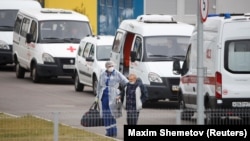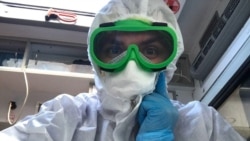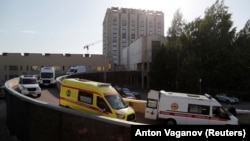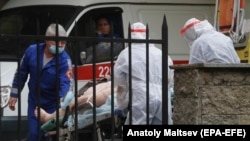Perm, Omsk, Ufa, Moscow, and more: In cities across Russia, doctors, patients, and relatives of those seeking treatment or testing for COVID-19 have often harrowing stories about the resurgence of the coronavirus in recent weeks.
"Even at night there are huge lines of 20-30 ambulances at the hospitals where they do CT scans," Artyom Boriskin, an ambulance driver in the Ural Mountains city of Perm, told Current Time.
"As a result, all of these ambulances are out of commission," Boriskin said -- meaning that they cannot pick up other patients while waiting for long stretches outside crowded hospitals.
In the Siberian city of Omsk, Marina, who asked that her full name not be used because "the government doesn't need the truth and one can suffer for revealing it," told a similar story about what happened when her mother developed a fever of 40 degrees Celsius on October 1.
"We called for an ambulance in the afternoon, but they arrived only at 2 a.m.," Marina told RFE/RL's Russian Service. "They stood in line at the CT facility until 9 a.m. When they arrived, there were about 20 ambulances in the line and over six hours they managed to deal only with about 10 of them.”
At 9 a.m., Marina's mother's ambulance returned to its dispatch station because the crew's shift was over. She was taken by another crew to yet another clinic for a CT scan.
In the end, she was sent home with a diagnosis of pneumonia.
"The CT scan showed 13 percent lung infection," Marina said. "The ambulance doctor told her that there was no point in taking her to a hospital because no one would admit her with such a number. Only those who are completely suffocating are hospitalized -- with lung infections no less than 30 percent."
Yury Kuznetsov, also of Omsk, told RFE/RL a similar story of what happened when his 54-year-old mother fell ill in late September. Her local clinic sent her home with antiviral medications and when her temperature rose to over 40 degrees, she waited more than six hours for an ambulance.
"In our clinics, they are indifferent to patients showing early signs of COVID," Kuznetsov said. "The workers there try to help, but they are hostages of the situation -- since the hospitals are full, they are obliged to send sick people home despite their condition. We have been living through a pandemic for six months, but our health-care facilities have not been able to reorient themselves. And with COVID, early treatment can be crucial."
Bashkortostan journalist Leyla Latypova posted on Twitter on October 15 that she had spent four hours the previous day waiting for an ambulance for an ailing relative. "All regional hospitals are at full capacity, tests are impossible to get if you are symptomatic...but the reported number of daily cases just recently went above 60," she wrote.
Dodgy Statistics
As is the case with many countries across Europe, Russia's official COVID-19 statistics show a decisive upward trend over the last month. The figures, which have been criticized for understating the real situation, show the number of new infections nationally rising to more than 14,000 on October 14 from about 5,700 a month earlier. A total of 286 new COVID deaths were reported on October 15, a figure that has not been seen since the spring.
Demographer Aleksei Raksha, who was fired from the state statistics agency in July after questioning the official COVID-19 numbers, said the government discredited itself by giving understated figures during the initial wave in the spring, undermining confidence now.
"I noticed that in the figures for new cases, in some regions the exact same number is given two days in a row or there is a difference of literally one case," Raksha said. "In the Krasnoyarsk region, for instance, they are apparently afraid to exceed the threshold of 100 cases -- the figures are hovering exactly at 100. In some regions, we have seen strange outbursts to totally new levels."
Ambulance medic Boriskin also doubts the official numbers he has seen. "According to statistics, most patients experience only mild coronavirus infections," he told Current Time, the Russian-language network led by RFE/RL in cooperation with VOA. "That means that if we have 60 [new patients daily] with serious cases, then there must be about 180-300 new infections out there. But when you look at the figures, you see there were only 80. This raises serious questions."
'Even Worse Than Spring'
"Things are much worse now than they were in May or June," said nurse Darya Savochkina, who works at an infectious-diseases hospital in Perm, a region that has risen in recent days into the 10 worst-affected Russian regions. "You can see this in the enormous number of patients, in the shortage of hospital beds, in the number of diagnoses, and in the overall amount of work. Patients also seem to be in more serious condition."
Throughout October so far, prominent Kremlin-friendly political analyst Sergei Markov has been chronicling his serious bout with COVID. He was treated in a well-equipped Moscow hospital, which he described as "overflowing" with coronavirus patients.
"It is absolutely clear that we are seeing a new peak of the epidemic," he wrote on October 11. "It is different in several ways from what we saw in the spring. From what I have seen, it is already worse than the spring. Everyone was expecting a second wave, but it came more quickly and more forcefully."
Markov argues that this time the government has developed the capacity to create the necessary number of hospital beds, so "this time there is no danger of the paralysis of the medical system and thus no stimulus to introduce a general quarantine."
Yekaterina Roshchina, a nurse at Moscow's Filatov Hospital, said the number of COVID patients was growing daily but that there is a sufficient number of hospital beds.
"The peak passed [earlier] in October," she said. "We are again pretty full and are coping the best we can. In the unit where I work, there were 69 patients [in the first wave] and now there are 69 patients -- not better, not worse. In the summer, we had just 50 patients, which was excellent."
On October 5, Russian Health Minister Mikhail Murashko acknowledged that Moscow was feeling "the first strike" of a second wave, but insisted that "the situation is manageable."
However, a survey of medical workers conducted at the end of September by the firm RNC Pharma and the professional organization Doctor At Work told a more worrying story.
Only 19 percent of respondents in Moscow and St. Petersburg said that their regions were "fully prepared" for a second wave of COVID-19 cases. Across the rest of Russia, the figure was only 8 percent.
Nationally, 24 percent of respondents said their regions were not prepared and had nothing "except rules."
Thirty-three percent said their regions were "absolutely not prepared and in a critical situation would 'throw doctors into the breach.'"




















